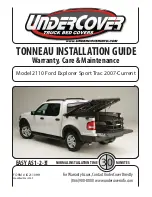
Driving with a trailer
When driving with a trailer, there are a number
of things that are important to remember as
regards the towbar, the trailer and how the load
is placed in the trailer.
Payload depends on the car's kerb weight. The
total of the weight of the passengers and all
accessories, e.g. the towbar, reduces the car's
load capacity by a corresponding weight.
The car is supplied with the equipment neces-
sary for driving with a trailer.
• The towbar on the car must be of an
approved type.
• Place the load in the trailer so that the pres-
sure on the car's towbar is compliant with the
specified maximum towball load. The towball
load is calculated as part of the car's payload.
• Increase the tyre pressure to the recom-
mended pressure for full load.
• The electric motor is under greater load than
normal when driving with a trailer.
• Do not drive with a heavy trailer when the car
is completely new. Wait until it has driven at
least 1000 km (620 miles).
• Follow the applicable regulations for permit-
ted speeds and weights.
• Maintain a low speed when driving with a
trailer up a long, steep slope.
• Avoid driving with a trailer in the case of
inclines steeper than 12%.
Trailer weights
When driving in hilly terrain and a hot climate
Under certain conditions, there may be a risk of
overheating when driving with a trailer. If the
electric motor and drive system overheat, a
warning symbol is illuminated in the driver dis-
play and a message is shown.
Parking on a hill
1. Depress the brake pedal.
2. Activating the parking brake.
3. Release the brake pedal.
Use chocks to chock the wheels when parking a
car with a connected trailer on a slope.
Hill starting
1. Depress the brake pedal.
2. Select gear position
D
or
R
and apply power.
> The parking brake releases and the symbol
in the driver display extinguishes. The car
can now be driven.
Related information
• Checking trailer lights (p. 403)
• Towing weights and towball loads (p. 545)
• Retractable and extendable tow bar
WARNING
Follow the specified trailer weight recom-
mendations. The entire combination may
otherwise be difficult to control under
braking and during evasive manoeuvres.
>>
Starting and driving 401
Summary of Contents for 2 2020
Page 1: ...Polestar 2 Manual ...
Page 2: ...TP xxxxx English AT 2007 MY21 Polestar 2018 2020 ...
Page 7: ...Section01 Manual information ...
Page 13: ...Section02 YourPolestar ...
Page 26: ...26 YourPolestar ...
Page 27: ...Section03 Safety ...
Page 66: ...66 Safety ...
Page 67: ...Section04 Displays andvoice control ...
Page 126: ...126 Displaysandvoicecontrol ...
Page 127: ...Section05 Lighting ...
Page 145: ...Section06 Windows glassand mirrors ...
Page 158: ...158 Windows glassandmirrors ...
Page 159: ...Section07 Seatsandsteering wheel ...
Page 172: ...172 Seatsandsteeringwheel ...
Page 173: ...Section08 Climate ...
Page 197: ...Section09 Key locksandalarm ...
Page 240: ...240 Key locksandalarm ...
Page 241: ...Section10 Driversupport ...
Page 346: ...346 Driversupport ...
Page 347: ...Section11 Electricoperationand charging ...
Page 371: ...Section12 Starting anddriving ...
Page 413: ...Section13 Audioandmedia ...
Page 429: ...Relatedinformation Wirelessphonecharger p 425 Audio and media 429 ...
Page 431: ...Section14 Polestar Connect ...
Page 441: ...Section15 Navigation ...
Page 450: ...450 Navigation ...
Page 451: ...Section16 Wheelsandtyres ...
Page 478: ...478 Wheelsandtyres ...
Page 479: ...Section17 Loading storage and passenger compartment ...
Page 493: ...Section18 Maintenanceand service ...
Page 540: ...540 Maintenanceandservice ...
Page 541: ...Section19 Specifications ...
















































